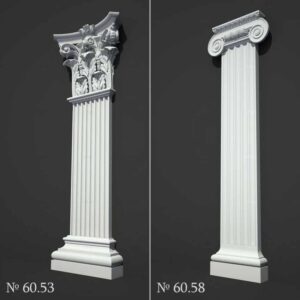Traditional Japanese bathroom design offers a unique approach to creating calming and harmonious spaces that encourage relaxation and rejuvenation. Focusing on simplicity, the integration of natural elements, and the connection between indoor and outdoor spaces, Japanese design principles can transform a bathroom into a soothing oasis. In this article, we’ll explore various traditional Japanese bathroom designs, showcasing the distinctive elements and techniques that can be employed to create visually stunning and functional spaces inspired by Japanese aesthetics.
Tranquil traditional Japanese bathroom design featuring a deep soaking tub and natural materials


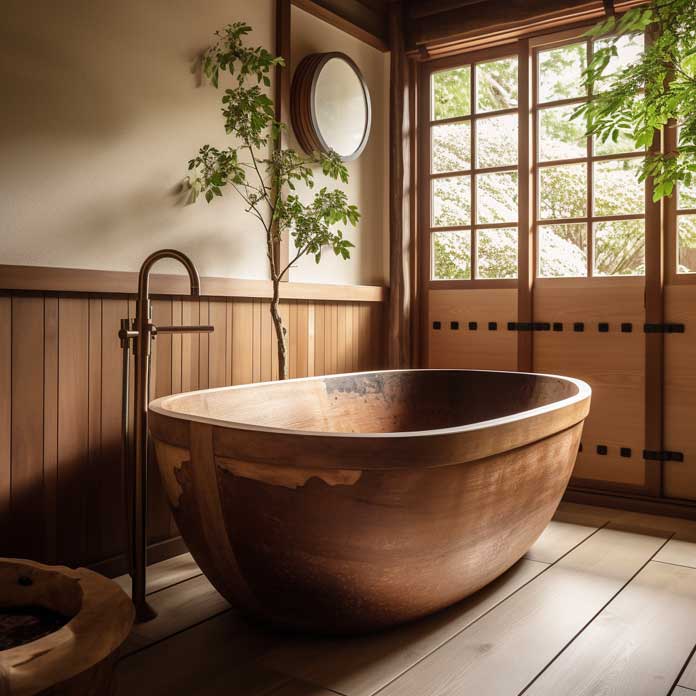
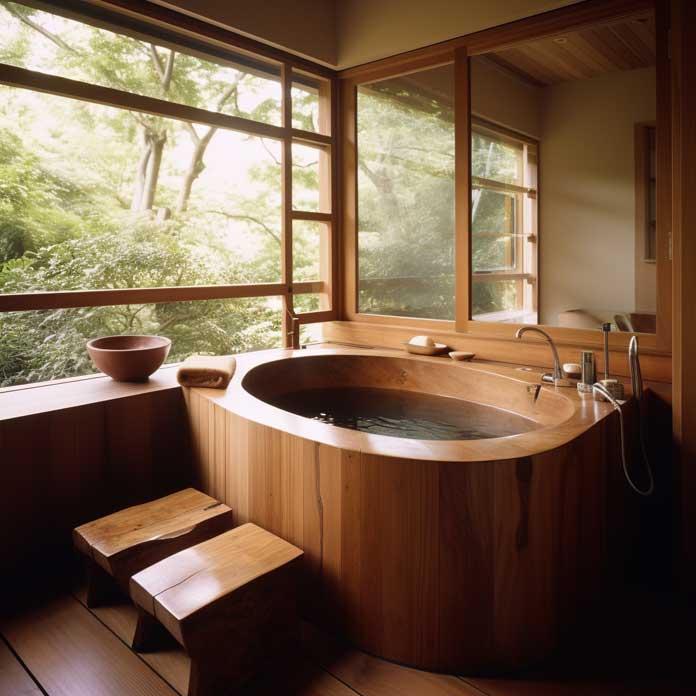
This serene traditional Japanese bathroom design captures the essence of relaxation with a deep soaking tub and an abundance of natural materials. The use of wood and stone elements evokes a sense of harmony with nature, a key component of traditional Japanese design.
The traditional Japanese bathroom design in this image showcases the importance of balance and simplicity. By carefully selecting and arranging elements, the space exudes a sense of peace and tranquility that is perfect for unwinding after a long day.
In this traditional Japanese bathroom design, the deep soaking tub, known as an ofuro, serves as a focal point for relaxation and rejuvenation. Designed for complete immersion, the ofuro is a cornerstone of Japanese bathing culture and an essential element in traditional Japanese bathroom design.
The use of natural materials in this traditional Japanese bathroom design not only adds warmth and texture to the space, but also connects the room to the natural world outside. This connection to nature is an important aspect of traditional Japanese design and promotes a sense of well-being and calm.
This traditional Japanese bathroom design exemplifies the beauty and elegance of Japanese aesthetics. By incorporating natural elements, clean lines, and a deep soaking tub, the space provides a soothing and restorative retreat for the body and mind.
Traditional Japanese bathroom design with a minimalistic layout and shoji screen accents

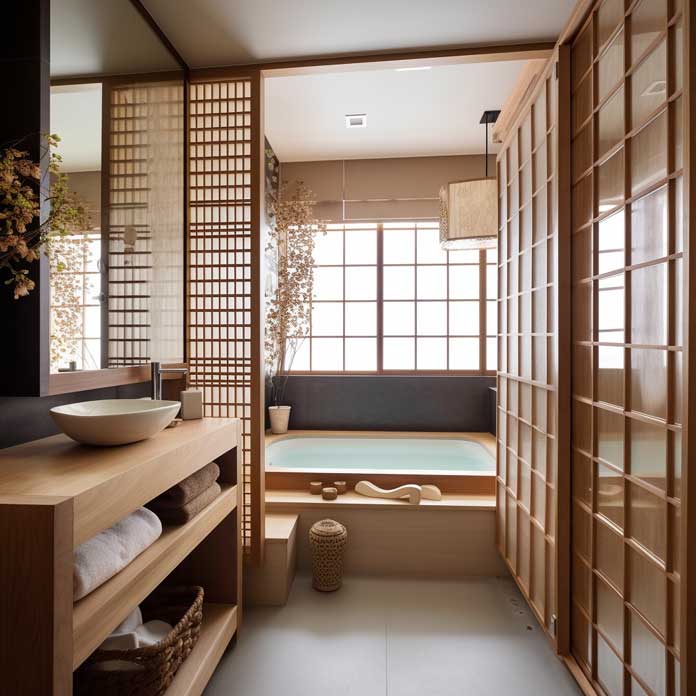
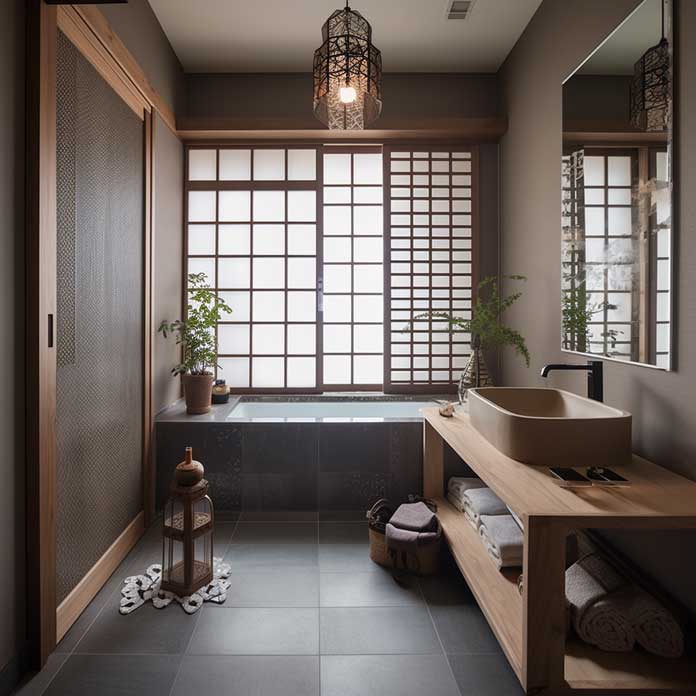
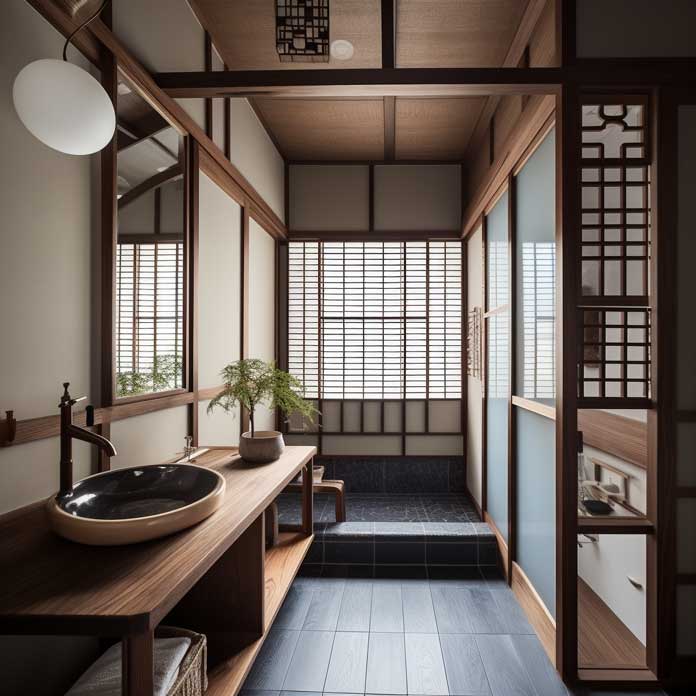
This striking traditional Japanese bathroom design embraces minimalism with its clean lines, uncluttered layout, and shoji screen accents. The shoji screens provide privacy while allowing natural light to filter through, creating a serene and calming atmosphere.
The minimalistic layout of this traditional Japanese bathroom design emphasizes the importance of negative space and unobstructed flow, both essential elements in Japanese aesthetics. The result is a harmonious and visually appealing space that encourages relaxation and mindfulness.
Shoji screen accents in this traditional Japanese bathroom design add a touch of authenticity and elegance. These traditional sliding panels, made of rice paper and wood, serve both a practical and decorative purpose, blending seamlessly with the overall design aesthetic.
This traditional Japanese bathroom design highlights the importance of cohesion and balance in creating a visually pleasing and calming space. The subtle use of color and textures, along with the inclusion of shoji screens, contributes to a soothing and unified environment.
The traditional Japanese bathroom design in this image demonstrates how minimalism can be both functional and aesthetically pleasing. By prioritizing simplicity and harmony, the space provides a tranquil retreat for relaxation and self-care.
Traditional Japanese bathroom design with a rock garden and floor-to-ceiling windows




This captivating traditional Japanese bathroom design features a beautiful rock garden and floor-to-ceiling windows, seamlessly integrating indoor and outdoor spaces. The rock garden, also known as a karesansui, adds a unique and meditative element to the bathroom, enhancing its peaceful ambiance.
In this traditional Japanese bathroom design, the floor-to-ceiling windows allow for an abundance of natural light, creating a bright and inviting atmosphere. The windows also provide a seamless connection to the outdoors, a key aspect of traditional Japanese design.
The rock garden in this traditional Japanese bathroom design serves as a calming focal point, encouraging mindfulness and contemplation. The meticulously arranged rocks and gravel are a nod to traditional Japanese garden design and contribute to the overall sense of harmony and balance.
This traditional Japanese bathroom design illustrates the importance of blending interior and exterior spaces to create a soothing and cohesive environment. The combination of the rock garden, natural materials, and floor-to-ceiling windows results in a bathroom that is both visually stunning and conducive to relaxation.
The traditional Japanese bathroom design in this image is an excellent example of how the integration of unique elements, such as the rock garden, can elevate a space while maintaining its core design principles. By incorporating elements that promote mindfulness and connection to nature, the bathroom becomes a sanctuary for rest and rejuvenation.
Traditional Japanese bathroom design with a teak wood floor and indoor plants

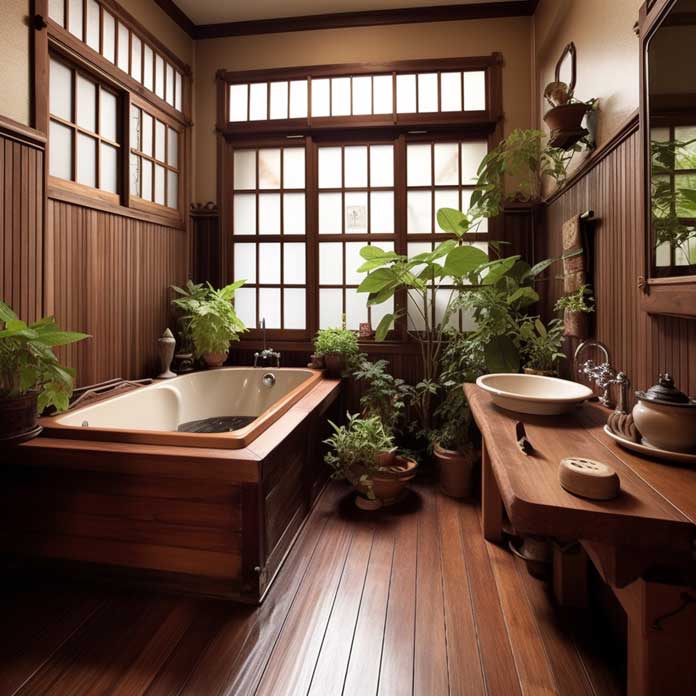


This inviting traditional Japanese bathroom design features a warm teak wood floor and an array of lush indoor plants, creating a cozy and rejuvenating atmosphere. The use of wood and greenery brings the essence of nature indoors, a key component of traditional Japanese design.
The teak wood floor in this traditional Japanese bathroom design not only adds warmth and texture to the space, but also provides a durable and water-resistant surface that is perfect for a wet area. The rich wood tones complement the overall aesthetic and create a sense of balance.
Indoor plants play a significant role in this traditional Japanese bathroom design, enhancing the connection to nature and promoting a sense of well-being. The plants help purify the air and add a vibrant touch of green to the space, further emphasizing the harmonious relationship between the indoors and outdoors.
This traditional Japanese bathroom design is a testament to the power of nature in enhancing a space’s ambiance and functionality. The teak wood floor and indoor plants work together to create an environment that is both visually appealing and soothing for the senses.
The traditional Japanese bathroom design in this image exemplifies the balance between simplicity and visual interest. By incorporating natural elements, such as the teak wood floor and indoor plants, the space achieves a sense of harmony while maintaining a visually captivating aesthetic.
Traditional Japanese bathroom design with an open-air concept and a private garden view




This stunning traditional Japanese bathroom design showcases an open-air concept with a private garden view, blurring the boundaries between indoor and outdoor spaces. The seamless integration of nature into the bathroom provides a serene and peaceful retreat, perfect for relaxation.
The open-air concept in this traditional Japanese bathroom design encourages a sense of unity with nature, allowing for an immersive and rejuvenating experience. The strategic placement of the bath and fixtures ensures privacy while maintaining a connection to the outdoors.
In this traditional Japanese bathroom design, the private garden view serves as a calming backdrop, enhancing the overall ambiance of the space. The lush greenery and natural elements create a tranquil setting that promotes relaxation and mindfulness.
The traditional Japanese bathroom design in this image demonstrates the importance of creating harmony between the indoors and outdoors in Japanese aesthetics. The open-air concept and private garden view work together to establish a bathroom that is both functional and visually stunning.
This traditional Japanese bathroom design is an excellent example of how thoughtful design choices can lead to a space that is both soothing and engaging. By incorporating an open-air concept and a private garden view, the bathroom embraces traditional Japanese aesthetics while providing a modern, luxurious experience.
Throughout this exploration of traditional Japanese bathroom design, we’ve seen how incorporating natural materials, minimalist layouts, and unique elements like rock gardens and shoji screens can result in beautiful and tranquil spaces. These design principles prioritize harmony, balance, and connection to nature, creating environments that encourage relaxation and mindfulness. By embracing the core principles of traditional Japanese bathroom design, you can create a timeless and versatile space that is both visually appealing and functionally practical.










